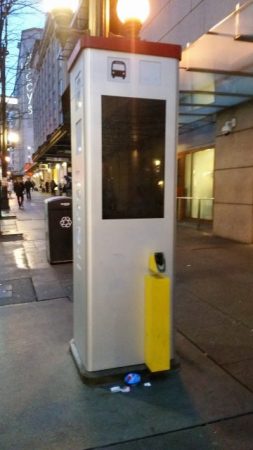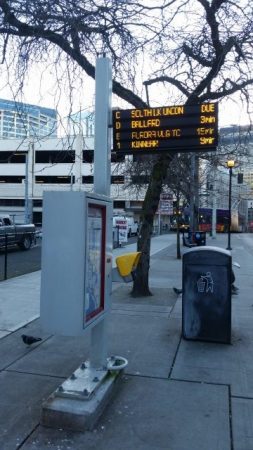Better OBA Kiosks Coming
 I was as happy as anyone when SDOT installed OneBusAway kiosks at major downtown bus stops. Although getting real-time data on one's phone is a huge advance, there is no substitute for an easy-to-read sign present at the stop.
I was as happy as anyone when SDOT installed OneBusAway kiosks at major downtown bus stops. Although getting real-time data on one's phone is a huge advance, there is no substitute for an easy-to-read sign present at the stop.
As the picture at right attests, however, the flat-panel TVs in these kiosks have significant maintenance challenges. SDOT's Sue Romero:
The original displays were chosen for the amount of arrival information that could be displayed on them. Many routes can be displayed simultaneously for busy bus stops serving multiple routes, compared to the LED readers that only display a few lines of text and therefore can only display a few routes at a time. However, the screens proved to be poorly manufactured and unreliable. We had an opportunity to apply that and other lessons learned to the C-Line design, and we've come up with a much more reliable and less expensive solution.
Last fall, SDOT began a project to replace the equipment with hardier televisions and new computers. SDOT's Sue Romero says that $23,000 replacements should arrive "before the end of spring" and installation should be done "before the end of summer."
 But I can't help but think of those Metro LED readers, like the one depicted from 3rd & Virginia. These signs range from 2-line, 1-sided ($8,000) to 4-line, 2-sided (as pictured) at $21,000, according to Metro's Jeff Switzer. And they work: anecdotally, they are almost never broken. Moreover, 3rd and Virginia is the first stop outside the skip-stop pattern and serves about as many routes (29) as the kiosk stops in the core (24 at 3rd & Pine),* so they can certainly handle high-volume stops.
But I can't help but think of those Metro LED readers, like the one depicted from 3rd & Virginia. These signs range from 2-line, 1-sided ($8,000) to 4-line, 2-sided (as pictured) at $21,000, according to Metro's Jeff Switzer. And they work: anecdotally, they are almost never broken. Moreover, 3rd and Virginia is the first stop outside the skip-stop pattern and serves about as many routes (29) as the kiosk stops in the core (24 at 3rd & Pine),* so they can certainly handle high-volume stops.
In terms of functional differences, reasonable people might disagree. Personally, I find the scrolling rate of the LED signs to be vastly superior to the TVs in the kiosks, and listing later arrivals of the same route in the kiosks to be redundant clutter. On the other hand, OBA's color-coding of the time lets you know when the time reflects the schedule and is therefore not trustworthy.
Usually functioning signage is clearly superior to usually broken signage, but I have to say I slightly prefer the LED signs to even fully reliable kiosks. But both are vastly superior to the ongoing signage fiasco directly below in the tunnel.
- * Inbound-only routes don't show up on OneBusAway, so the number of routes either stop displays is considerably lower.